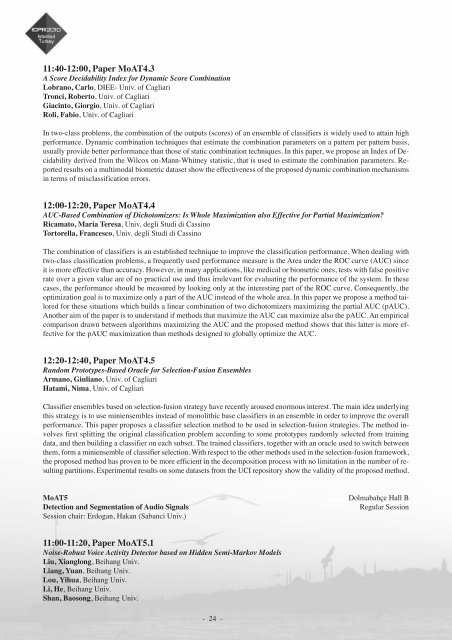Abstract book (pdf) - ICPR 2010
Abstract book (pdf) - ICPR 2010
Abstract book (pdf) - ICPR 2010
- TAGS
- abstract
- icpr
- icpr2010.org
Create successful ePaper yourself
Turn your PDF publications into a flip-book with our unique Google optimized e-Paper software.
11:40-12:00, Paper MoAT4.3<br />
A Score Decidability Index for Dynamic Score Combination<br />
Lobrano, Carlo, DIEE- Univ. of Cagliari<br />
Tronci, Roberto, Univ. of Cagliari<br />
Giacinto, Giorgio, Univ. of Cagliari<br />
Roli, Fabio, Univ. of Cagliari<br />
In two-class problems, the combination of the outputs (scores) of an ensemble of classifiers is widely used to attain high<br />
performance. Dynamic combination techniques that estimate the combination parameters on a pattern per pattern basis,<br />
usually provide better performance than those of static combination techniques. In this paper, we propose an Index of Decidability<br />
derived from the Wilcox on-Mann-Whitney statistic, that is used to estimate the combination parameters. Reported<br />
results on a multimodal biometric dataset show the effectiveness of the proposed dynamic combination mechanisms<br />
in terms of misclassification errors.<br />
12:00-12:20, Paper MoAT4.4<br />
AUC-Based Combination of Dichotomizers: Is Whole Maximization also Effective for Partial Maximization?<br />
Ricamato, Maria Teresa, Univ. degli Studi di Cassino<br />
Tortorella, Francesco, Univ. degli Studi di Cassino<br />
The combination of classifiers is an established technique to improve the classification performance. When dealing with<br />
two-class classification problems, a frequently used performance measure is the Area under the ROC curve (AUC) since<br />
it is more effective than accuracy. However, in many applications, like medical or biometric ones, tests with false positive<br />
rate over a given value are of no practical use and thus irrelevant for evaluating the performance of the system. In these<br />
cases, the performance should be measured by looking only at the interesting part of the ROC curve. Consequently, the<br />
optimization goal is to maximize only a part of the AUC instead of the whole area. In this paper we propose a method tailored<br />
for these situations which builds a linear combination of two dichotomizers maximizing the partial AUC (pAUC).<br />
Another aim of the paper is to understand if methods that maximize the AUC can maximize also the pAUC. An empirical<br />
comparison drawn between algorithms maximizing the AUC and the proposed method shows that this latter is more effective<br />
for the pAUC maximization than methods designed to globally optimize the AUC.<br />
12:20-12:40, Paper MoAT4.5<br />
Random Prototypes-Based Oracle for Selection-Fusion Ensembles<br />
Armano, Giuliano, Univ. of Cagliari<br />
Hatami, Nima, Univ. of Cagliari<br />
Classifier ensembles based on selection-fusion strategy have recently aroused enormous interest. The main idea underlying<br />
this strategy is to use miniensembles instead of monolithic base classifiers in an ensemble in order to improve the overall<br />
performance. This paper proposes a classifier selection method to be used in selection-fusion strategies. The method involves<br />
first splitting the original classification problem according to some prototypes randomly selected from training<br />
data, and then building a classifier on each subset. The trained classifiers, together with an oracle used to switch between<br />
them, form a miniensemble of classifier selection. With respect to the other methods used in the selection-fusion framework,<br />
the proposed method has proven to be more efficient in the decomposition process with no limitation in the number of resulting<br />
partitions. Experimental results on some datasets from the UCI repository show the validity of the proposed method.<br />
MoAT5 Dolmabahçe Hall B<br />
Detection and Segmentation of Audio Signals Regular Session<br />
Session chair: Erdogan, Hakan (Sabanci Univ.)<br />
11:00-11:20, Paper MoAT5.1<br />
Noise-Robust Voice Activity Detector based on Hidden Semi-Markov Models<br />
Liu, Xianglong, Beihang Univ.<br />
Liang, Yuan, Beihang Univ.<br />
Lou, Yihua, Beihang Univ.<br />
Li, He, Beihang Univ.<br />
Shan, Baosong, Beihang Univ.<br />
- 24 -



